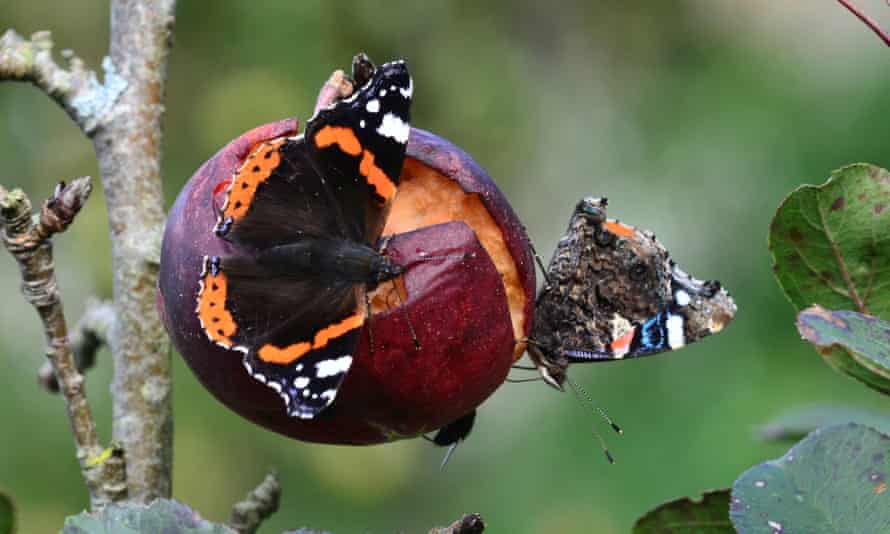Number of butterflies in the UK at a record low, survey finds
Experts say results of Butterfly Conservation’s latest survey signal that nature is ‘in crisis’

The UK has recorded its lowest ever number of butterflies in an annual survey of the insects, prompting conservationists to warn that nature is in crisis.
Butterfly Conservation, which counted butterflies and moths between 16 July and 8 August, said the results, released on Thursday, marked the lowest numbers since the Big Butterfly Count started 12 years ago and called for urgent action to be taken.
It is the latest warning sign for butterflies – which, as well as forming a vital part of the food chain, are considered significant indicators of the health of the environment – after decades of decline. Since 1976, 76% of butterflies have declined either in abundance or distribution.
Julie Williams, the charity’s chief executive, said: “The facts are clear. Nature is in crisis and we need urgent action, not just to prevent further species losses but to rebuild biodiversity.”
Of the 150,000 counts registered in this year’s snapshot, the most submitted to date, volunteers counted an average of nine butterflies or moths each count, down from an average of 11 last year and 16 in 2019.
Overall, there were 1,238,405 butterflies and moths counted – a 14% reduction on last year. The survey is carried out by volunteers who count the number and type of butterflies or moths they see in 15 minutes.
Among the species with significantly reduced counts were the small tortoiseshell, which dropped 32% and is in long-term decline in the UK, and the peacock butterfly, which was 63% down on last year and had its lowest count since 2012. Others that saw marked drops on last year were the comma (-32%), speckled wood (-41%) and common blue (-59%).
There were higher numbers of ringlets and marbled whites in this year’s count, which rose by 81% and 213% year-on-year respectively. But, the charity warned, the increases could simply reflect lower counts last year.
Zoe Randle, a senior surveys officer at Butterfly Conservation, said an extremely wet May, which brought the UK’s fourth-highest amount of rainfall on record for the month, was a significant factor for butterfly numbers, hindering their breeding and feeding.
“Butterflies don’t like the rain at all, they’re coldblooded insects. Effectively they’re solar-powered,” she said.
This was especially bad for species that produce two broods a year, most of which had their worst year in the history of the survey. “That first brood would have been really hammered by that wet May. So breeding success would have been limited, which led to fewer offspring being available to create the second generation,” said Randle, adding that it would have a knock-on effect on next year’s count.
And with extreme weather events expected to increase as a result of climate breakdown, it is feared the long-term impact on butterflies and moths could be devastating.
Butterfly Conservation has pledged to halve the number of threatened species in the UK, double its impact on landscape restoration and encourage people to create new wild nature spaces.
If action was not taken to protect them, Randle said, it would lead to a “continued degradation of the environment and the natural world”.
In addition to unusual weather patterns, Brian Eversham, an entomologist and the chief executive of Bedfordshire, Cambridgeshire and Northamptonshire Wildlife Trust, said insects were facing numerous pressures including habitat loss, polluted waterways and dangerous pesticide use.
But, he added: “While these findings are unsettling, we shouldn’t underestimate nature’s ability to recover if given a chance. We can all help by creating more habitats for wildlife.”
Top 10 species counted in the UK in the Big Butterfly Count 2021
1. Small White (252,151 counted; -5% on 2020)
2. Large White (229,218; -16%)
3. Meadow Brown (197,060; +33%)
4. Gatekeeper (133,726; -30%)
5. Red Admiral (75,394; -10%)
6. Ringlet (63,311; +81%)
7. Peacock (61,668; -63%)
8. Small Tortoiseshell (38,543; -32%)
9. Marbled White (28,704; +213%)
10. Green-veined White (27,784; -9%)